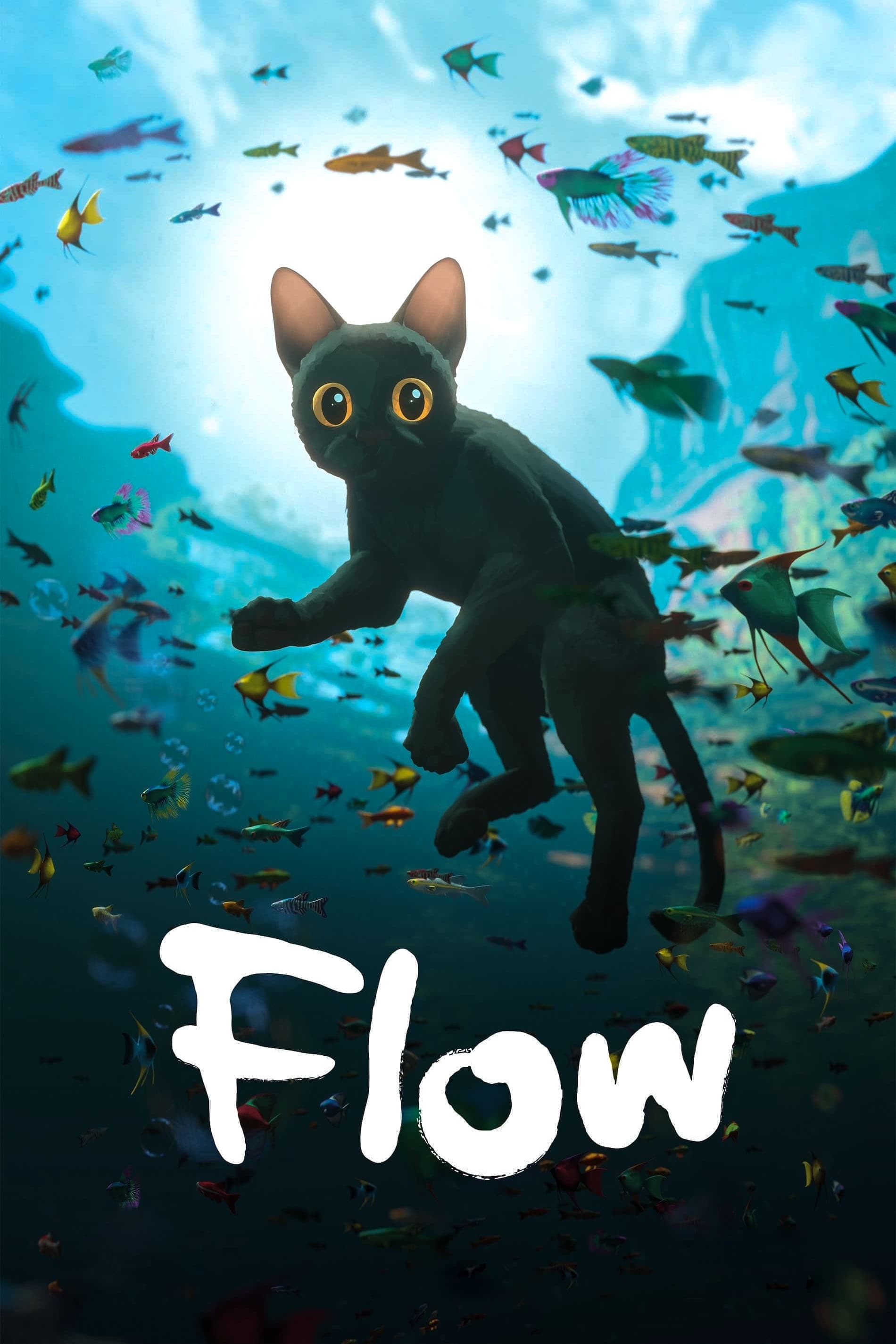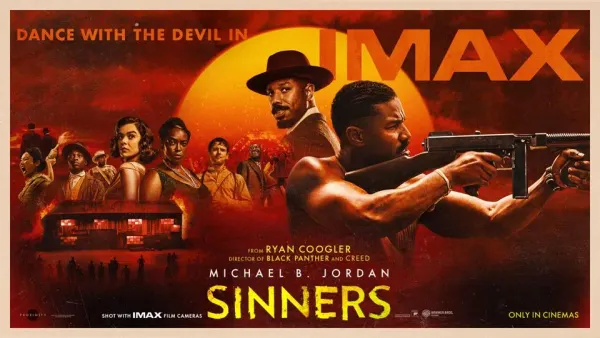Swept Away by 'Flow': Diving into the Silent Majesty of 2024's Animated Triumph
Sometimes, the quietest films speak the loudest.

Sometimes, the quietest films speak the loudest. I often find myself drawn to cinema that trusts its audience, that relies on the pure power of image and sound rather than explicit exposition. It’s a rare treat in today’s landscape, which makes the arrival and subsequent triumph of Gints Zilbalodis’s Flow feel like discovering a hidden current – powerful, deep, and utterly mesmerising. This animated feature, a co-production hailing from Latvia, France, and Belgium, seemed to emerge from tranquil waters only to create tidal waves across the film world. It tells the simple, yet profound story of a solitary cat caught in a world mysteriously submerged by a great flood, forced onto a small sailboat already occupied by a motley crew of other animals. And it does so entirely without dialogue.
The buzz surrounding Flow became impossible to ignore. It wasn't just festival buzz; it was a cascade of accolades – multiple wins at the prestigious Annecy International Animation Film Festival, glowing critical acclaim (a stunning 97% on Rotten Tomatoes and an 87 "universal acclaim" score on Metacritic ), a Golden Globe for Best Animated Feature, and ultimately, the Academy Award for Best Animated Feature. This Oscar win wasn't just an award; it was Latvia's first-ever Oscar, and the first time an independent film claimed the Best Animated Feature prize. Even Guillermo del Toro, a master of visual storytelling himself, offered breathtaking praise: "If I could wish for the future of animation, these images would be its magnificent, breathtaking start". High praise indeed, and it sets a certain expectation.
So, what makes Flow connect so deeply, resonating across cultures and age groups despite its lack of spoken language? For me, this review is a personal dive into exploring just that. It’s about unpacking the artistry behind its silent narrative, the surprising depth of its animal characters, the unique beauty of its visuals, the crucial role of its soundscape, and the universal themes that ripple beneath the surface.
Crucially, the dialogue-free approach isn't a mere stylistic choice; it's the foundational principle upon which the film's entire artistic strategy is built. Director Gints Zilbalodis has openly stated his comfort in telling stories visually, through music and sound, rather than words. This self-imposed constraint becomes a catalyst for immense creativity. Without dialogue to lean on, every other cinematic tool must work harder and smarter. The expressiveness of the animation, the nuance of the camera movement, the intricate layering of the sound design – all must carry the weight of emotional expression and narrative progression. This demands more from the filmmakers, but also invites the audience into a more active, interpretive relationship with the film, fostering a connection that transcends language barriers, as evidenced by its global success. Furthermore, Flow's journey from a relatively low-budget (€3.5M estimated ) independent production by a small team to conquering the industry's highest awards is a powerful statement. It challenges the dominance of major studios and validates the potential of international co-productions and independent voices in animation. Achieved using accessible tools like Blender, its success story is incredibly empowering, suggesting that artistic vision and compelling storytelling can indeed rival massive budgets and marketing campaigns, potentially inspiring animators worldwide.
Speaking Volumes Without a Word: Narrative & Rhythm
At its core, Flow's plot appears deceptively simple: a story of survival, an unexpected journey, and the tentative formation of community amidst disaster. We follow a linear path dictated by the rising waters – a catastrophic flood that serves as the inciting incident, forcing our feline protagonist from its solitary life. The narrative unfolds episodically as the Cat finds refuge on a small sailboat and encounters other animal survivors, navigating the dangers of their newly aquatic world together.
But the how of the storytelling is where Flow truly distinguishes itself. In the absence of dialogue, the film communicates through a rich tapestry of purely cinematic language. Character motivations, relationships, and plot developments are conveyed through meticulous animation, subtle gestures, environmental cues (the haunting vestiges of human civilisation submerged beneath the waves speak volumes about a world transformed ), and an evocative soundscape. Zilbalodis has cited the legendary Jacques Tati as an inspiration, and you can feel that influence in the film's trust in visual gags, character behaviour, and environmental interaction to carry the narrative weight.
The film's pacing is deliberate, embracing a rhythm that feels both natural and meditative. Reviews and interviews mention the use of long takes and an overall "flowing" quality, which I certainly felt. Instead of rushing from one plot point to the next, the film allows moments to breathe. This creates a deeply immersive experience, letting the viewer soak in the atmosphere, observe the subtle dynamics between the animals, and connect with the emotional landscape of the journey. This stands in contrast to the often frenetic pace of mainstream animation, demanding a different kind of attention but offering a richer, more contemplative reward. At around 85 minutes, the runtime feels perfectly attuned to this style, never overstaying its welcome but allowing its simple story ample space to resonate.
The flooded world itself is more than just a backdrop; it's an active participant in the narrative. The rising water isn't merely a setting; it's the engine of the plot, forcing the Cat into the unknown and necessitating the formation of the unlikely ark community. The specific challenges presented by this environment – navigating treacherous ruins, seeking scarce patches of dry land, dealing with the sheer overwhelming presence of water – directly shape the animals' interactions, forcing cooperation and revealing character through action. The visuals of human structures succumbing to nature wordlessly convey powerful ideas about ecological balance, the transience of human endeavours, and perhaps a world healing itself post-humanity. Zilbalodis himself confirmed that the story is told through the environment, making the world an undeniable force in the film.
Structurally, the film is elegantly framed by scenes of characters observing their reflections. This motif bookends the journey, suggesting a thematic arc related to self-awareness, change, or perhaps the recognition of oneself within a larger community. While mostly grounded, the narrative isn't afraid to drift into more mystical or surreal territory, described by the director as an "intuitive flow of fantasy". These moments, perhaps reminiscent of Zilbalodis's earlier work Away, add layers of interpretation without breaking the film's spell. While some have noted parallels to Noah's Ark, the film wisely avoids becoming a heavy-handed allegory, keeping its focus firmly on the animals' immediate experience.
A Boatload of Personality: Characters & Connection
The heart of Flow beats within its beautifully realized animal characters. Our protagonist is an independent, somewhat aloof black cat – a creature comfortable in its solitude until disaster strikes. Its initial fear, particularly its aversion to water (a universally understood cat trait cleverly utilised), makes its forced journey across a flooded world instantly compelling. We witness a gradual, believable transformation from pure self-preservation to cautious curiosity, and eventually, to a tentative acceptance of interdependence. This arc feels deeply personal, and indeed, Zilbalodis has linked the Cat's journey to his own anxieties and experiences transitioning from working completely alone on Away to collaborating with a team on Flow. The Cat learns to trust, mirroring the director's own process. This transformation is conveyed not through grand pronouncements, but through subtle shifts in posture, shared glances, and small gestures like a gentle rubbing of noses.
Joining the Cat on its precarious voyage is a wonderfully diverse ensemble. There's a large, seemingly lazy Capybara who drifts along with a quiet wisdom; a perpetually optimistic and friendly Labrador dog eager to please; a small, mischievous Lemur full of curiosity; and a majestic Secretary Bird who takes on a protective, almost parental role. Later, a potentially less trustworthy Labrador and even a colossal, benevolent whale enter the picture. Each animal's personality emerges distinctly through their design, movement, and interactions, creating a vibrant microcosm aboard the boat.
A key aspect of the film's success is its approach to characterisation, striving to keep the animals feeling like animals, rather than humans in furry costumes. Zilbalodis aimed to avoid typical anthropomorphism – no witty banter, no human-like postures or motivations superimposed onto the creatures. For the most part, they behave in ways that feel true to their species, grounding the extraordinary situation in believable actions and reactions. The animators reportedly studied animal behaviour extensively, watching pet videos and visiting zoos to capture authentic movements and expressions. Of course, telling a structured story requires some "artistic liberties," as Zilbalodis calls them. The most notable is the animals' ability to steer the sailboat. This departure from strict realism is crucial, however, as it grants the characters agency. It allows them to make choices, express differing viewpoints, and actively participate in their fate – essential elements for character development and thematic exploration when dialogue isn't an option. Their actions become their dialogue, revealing their internal states and driving the narrative forward.
This careful balance between naturalism and necessary agency fosters incredible empathy. Watching the film in a festival audience, the shared laughs and sniffles were palpable – proof of the deep connection forged with these non-verbal characters. This empathy stems from multiple sources: the inherent vulnerability of the animals in their perilous situation, the universality of their struggle for survival, and the sheer artistry of the animation, which captures micro-expressions and subtle emotional shifts with remarkable precision. Adding another layer of complexity, the film presents contrasting character arcs that enrich its themes. While the Cat journeys from independence towards community, the initially dependent Dog evolves towards greater self-reliance and independent thought. Zilbalodis intentionally designed these opposing paths to explore the "pros and cons of both thinking patterns", suggesting a nuanced view where both independence and interdependence hold value. The steady Capybara, meanwhile, acts as a calm anchor, perhaps representing a state of achieved balance.
Painting with Pixels: The Visual World of 'Flow'
Visually, Flow is breathtaking. It utilises 3D computer-generated animation, but achieves an aesthetic far removed from the hyperrealism or overt cartoonishness often seen in the medium. The look is stylised, graphic, almost painterly. Zilbalodis and his team used Blender, an open-source software, and specifically its EEVEE real-time render engine, to craft this unique visual identity. This choice was instrumental, enabling a relatively small independent team to realise such an ambitious vision. Zilbalodis praised EEVEE's speed and integrated workflow, which allowed him to work intuitively, adjusting lighting, camera angles, and materials simultaneously to achieve the desired look without the prohibitive render times often associated with complex CG. Astonishingly, the entire film was reportedly rendered on his personal PC, with frame times ranging from just 0.5 to 10 seconds in 4K, and without relying on a separate compositing stage.
The visual details are exquisite. Textures of fur and feathers feel tangible yet stylised. Water, notoriously difficult to animate, is rendered with convincing weight and fluidity. Light and colour are handled with artistic intention, often adjusted directly through shaders to create specific moods and guide the eye. The environments themselves are lush and detailed, from verdant foliage reclaiming land to the crumbling, waterlogged architecture of a lost human world. Yet, the film embraces a kind of calculated imperfection. Zilbalodis spoke of wanting to see "brush strokes," of leaving some details abstracted, and not rendering every single hair on the animals. This intentional lack of photographic precision enhances the graphic quality, prevents the visuals from feeling sterile, and focuses attention on emotional expression rather than just technical fidelity. It’s a move away from CG realism towards something more evocative and artistically curated.
The cinematography further enhances the film's immersive quality. The camera often stays close to the animals, adopting their perspective and fostering intimacy. Long, fluid takes are frequently employed, following the characters seamlessly as they navigate their environment, reinforcing the sense of continuous movement and lived experience. Some have noted an almost "handheld" feel to the camera at times, an effect Zilbalodis achieved by layering different types of keyframed motion rather than relying on less precise live-action camera capture. Composition and framing are carefully considered, using the visual language to underscore emotions and relationships.
Together, these elements – the stylised rendering, meticulous detail, intentional imperfections, and fluid camerawork – conjure a world that feels simultaneously real and mystical, beautiful and perilous. The visuals are not just decoration; they are integral to the storytelling, creating a palpable atmosphere and conveying thematic weight, as seen in the powerful image of a whale gliding silently through the ruins of a submerged city.
The Sounds of Silence (and Survival): Music & Sound Design
In a film devoid of dialogue, sound design ascends from a supporting role to become a primary narrative voice. Flow masterfully utilises its soundtrack to build its world, convey emotion, and drive the story forward.
The musical score, co-composed by Zilbalodis himself alongside Rihards Zaļupe, is used thoughtfully and effectively. It’s not a constant presence, but rather emerges to underscore key moments, enhancing tension, evoking wonder, or providing solace. Described as having a "sublime minimalism", the score complements the visuals without overwhelming them, and its quality was recognised with the Best Original Music award at Annecy.
Equally crucial are the ambient sounds and specific sound effects. The team invested heavily in creating a believable and immersive auditory world. There's a strong emphasis on realism, particularly with the animal vocalisations. Rather than using generic library sounds, they recorded real animals – pets, creatures at the zoo – striving for authenticity. They even sought out specific dog breed sounds and, after some searching, used the bleat of a baby camel to give the languid Capybara its voice. This commitment to realistic animal sounds is vital. In the absence of human language, these growls, meows, chirps, and cries become the characters' primary means of expressing fear, contentment, warning, or affection. The sound design effectively functions as a substitute for dialogue, making the animals' emotional states clear and their interactions meaningful.
The film also understands the power of quiet. Silence is used dynamically, creating contrast with moments of action or heightened emotion. A sudden hush can amplify tension before danger strikes, while quiet, intimate scenes gain impact when juxtaposed with the vast, ambient sounds of the surrounding world. The entire soundscape works in concert with the visuals to create a rich, sensory experience that draws you completely into the animals' plight.
Beneath the Surface: Unpacking the Themes
While Flow captivates on a purely sensory level, it also resonates with rich thematic depth. Several core ideas emerge clearly from the animals' journey. Survival is paramount, the driving force behind every action. The film is structured as an odyssey, a journey through a transformed world. Central to this journey is the tension between individualism and community. The Cat begins as a loner but must learn the value of friendship, trust, and cooperation to endure. Adaptation is key – the animals must constantly adjust to the challenges of their new reality. Fear, particularly the Cat's fear of water and initially of connection, must be confronted. Yet, amidst the peril, there's an undercurrent of hope, a sense that life finds a way.
Nature is portrayed as an immensely powerful force - indifferent, capable of immense destruction through the flood, yet also possessing breathtaking beauty and resilience. While Zilbalodis has stated that an environmental message wasn't his primary focus, the imagery inevitably evokes thoughts about climate change and humanity's impact on the planet. The post-human setting, with its submerged cities and monuments, invites contemplation on what remains when we are gone, and how nature might reclaim its space.
Interestingly, the film also functions as a personal allegory for its creator. Zilbalodis explicitly connected the Cat's journey of learning to trust and collaborate with his own experience moving from the solitary creation of Away to leading a team for Flow. This adds a layer of poignant autobiography to the narrative.
What makes these themes land so effectively, I believe, is the film's commitment to specificity. By focusing on the grounded, believable behaviour of these animals within their concrete situation, Flow taps into universal emotions and instincts. We relate to the fear, the need for connection, the struggle to survive, precisely because the characters feel like real creatures facing a real threat, not just symbolic stand-ins. This specificity allows the universal themes to emerge organically, resonating across different audiences. Furthermore, the ambiguity surrounding the cause of the flood and the fate of humanity is a strength. Zilbalodis intentionally avoided crafting a detailed backstory, allowing the disaster to function on multiple levels – literal, metaphorical, mythological – without becoming didactic. This keeps the focus squarely on the animals' emotional journey and invites personal interpretation, making the experience richer and more engaging. Some viewers might even find deeper, spiritual overtones in certain moments, like the poignant scene involving the Secretary Bird's fate or the recurring motif of reflection suggesting burgeoning self-awareness.
Looking Back: From 'Away' to 'Flow'
To fully appreciate Flow, it helps to consider it in the context of Gints Zilbalodis's burgeoning career. His debut feature, Away (2019), was itself a remarkable achievement – an animated feature created entirely by himself, also dialogue-free. Both films share a distinctive visual sensibility and a reliance on environmental storytelling, following protagonists on challenging journeys through evocative landscapes.
However, the shift from Away to Flow marks a significant evolution. Away was the ultimate solo endeavour, both in its production and potentially in its themes of solitary struggle. Flow, made with a collaborative team, feels like a direct response. Its central theme revolves around the difficulties and rewards of coming together, mirroring the director's own transition to a collaborative workflow. If Away was about the journey of the individual, Flow is about the complex dynamics of the group. The scale feels larger, the character interactions more intricate. The hints of surrealism present in Flow might echo Away , but the focus here is firmly on the relationships forged in the face of shared adversity. Seen together, the two films form a compelling diptych charting an artist's evolution from solitary vision to shared creation.
Within the broader landscape of contemporary animation, Flow stands out distinctly. It offers a sophisticated, emotionally resonant experience that contrasts sharply with the often dialogue-heavy, fast-paced narratives of many mainstream studio films. Its success demonstrates the artistic heights that independent animation can achieve, using CG technology not just for spectacle or realism, but for nuanced, painterly expression. It joins the ranks of significant international animated features that push the boundaries of the medium, proving that powerful stories can be told in diverse styles and from unique perspectives.
Why 'Flow' Resonates
Bringing together its masterful silent storytelling, deeply felt character arcs, stunning visual artistry, and evocative sound design, Flow is more than just an animated film; it's a profound cinematic experience. It manages to convey a wealth of emotion and narrative complexity without a single word of dialogue, relying instead on the universal language of observation, empathy, and shared struggle. The journey of the Cat and its companions is immersive, tense, and ultimately incredibly moving.
Its impact is undeniable. As a piece of cinema, it offers a unique and absorbing experience. As an artistic achievement, it pushes the boundaries of animated storytelling and visual style. And as a cultural moment, it represents a landmark achievement for Latvian cinema and a major victory for independent animation on the global stage.
I wholeheartedly recommend seeking out Flow. It’s a film for anyone who appreciates artistry in animation, for lovers of visual storytelling, for those moved by tales of resilience and connection, and certainly for animal lovers. It lingers long after the credits roll, a testament to the power of a singular artistic vision brought to life through collaboration. Perhaps its most enduring legacy, beyond the well-deserved awards, will be its role as an inspiration. Flow powerfully demonstrates how accessible technology, a clear creative voice, and storytelling that taps into universal human (and animal) experience can transcend borders and budgets, potentially encouraging a whole new wave of diverse and independent voices in animation worldwide. If you haven't watched it yet, don't miss the chance to be swept away by it.






